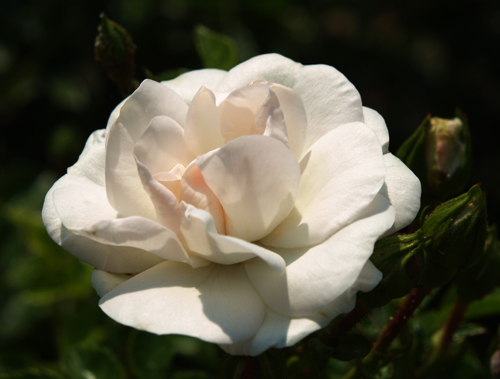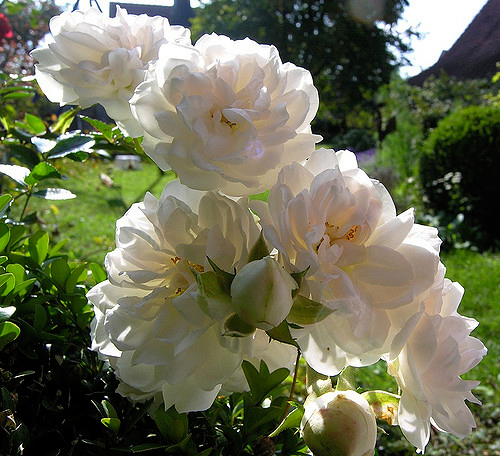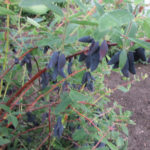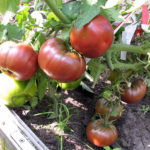Rose Swany
Creators of "green landscapes" are constantly faced with the need to use plants that would serve as a low "living carpet" covering the surface of the earth. There was even a concept - "ground cover plants" designed to fulfill this role. Among them there are roses - but how can one do without such beauty! The variety that we will now describe belongs to this group.

History of creation
The idea to lay rose shoots on the ground was born at the end of the century before last. After all, it seemed so tempting to gardeners to create not just a green, but a beautifully flowering living carpet! Accordingly, work began on the development of special varieties: they were supposed to be squat, with thin but long shoots lying on the surface of the soil.
But after the First World War, the popularity of such roses declined sharply, they were considered outdated, unfashionable. A new wave of demand emerged only in the 70s of the last century. It was then, in 1977, through the efforts of the legendary French specialist Marie-Louise Mailland, that the Swanee variety was created. He became a reference, exemplary ground cover rose, which has not lost its popularity to this day.
Kennel "Meilland", which is the originator of the variety, initially gave it the technical name MEIburenac, although at the first exhibition it was presented under its current name. It is known that two plants were used to create the variety: the evergreen rosehip (Latin Rosa Sempervirens) and the Mademoiselle Marthe Carron rose.
Rich family
It is not surprising that over the years the Meilland company, taking into account the popularity of its brainchild, has created on its basis several new varieties bearing the same name. To avoid confusion, we will briefly write about them.
Pink Swany
Appeared on the European market in 2003. It grows in the form of a low bush, with an average height of 50-60 cm. The flowers are large, densely double, old-fashioned, pale pink color, sometimes turning into a weak violet. Flowering continues throughout the season, up to frost.

Super Swany
Created in 1987 under the technical name MEIcoublan. It looks like a sturdy, sprawling bush up to 1.4 meters high (but usually slightly lower). The flowers are almost white, with delicate pinkish edges, densely double. There can be fifty or more petals, the flower itself is of medium diameter, has no smell. Differs in disease resistance and versatility in use.
Swany Mimi
Year of birth 2001, technical name MEIshasen. Often sold under the name Mimi Eden. Bushes of medium height, almost devoid of thorns. The flowers are painted in a faint pink color, along the edges of the petals gradually turn white. The overall impression of the bush is a whitish pink ball. The size of the flowers is small, about 3 cm in diameter, but there are many of them and they are collected in dense, numerous brushes.
Swany River
Unlike previous varieties, this one did not originate in Meilland nurseries, but in South Africa in 2001. Its author is the breeder Jean Gerhold. The plant is a white hybrid tea rose, little known in the current European flower market.
Description of appearance
But let us finally deal with our Swanee! The fact that she belongs to the group of ground cover roses has already been said. Branched bush, with a maximum height of half a meter, but usually significantly lower. Shoots are thin and long, growing almost parallel to the ground and lying easily on its surface. Leaves are juicy green, slightly shiny, less than average in size.

Each stem forms an inflorescence of about ten small, about 4-5 cm in diameter, white flowers. There is a slight pink tint in the center of the flower. The scent is barely audible, but it is always present. The first buds appear early, sometimes already at the end of spring, and continue to bloom almost until frost. There may be a short break in summer, especially in dry weather.
Features of agricultural technology and use
Resistance to low temperatures is average, according to the US Department of Agriculture (USDA), it can grow in a zone no colder than 6th.However, given the low height, it is quite easy to cover such bushes. It perfectly tolerates strong pruning, vigorously and quickly grows back by mid-spring. Moreover, this variety requires constant pruning, removal of old, thickened shoots.
Swani is used not only to decorate hills and small areas of the garden as a ground cover plant (although this is the main purpose of the variety). It is beautiful as a curb rose, looks great on the site against the background of green foliage. With skillful shaping, the rose can be grown as a small bush or as a container plant. Looks great when cut, flowers do not fade for a long time. Moreover, some gardeners use it as weaving, to decorate low fences and fences. To do this, thin shoots should be constantly tied to a support.









I can't decide what I feel about this rose ... On the one hand, it is good - it winters well, practically does not get sick, it blooms super profusely all season, from spring to late autumn, blooms with “caps” of not large, but pretty flowers. On the other hand, there are two very big drawbacks: the rose does not cleanse itself, that is, after flowering does not shed its petals, with age the flower is darker, acquiring a dark color - it does not fly off, as a result the whole bush looks "dirty" and sloppy, the second drawback is it has practically no aroma (well, very faint).